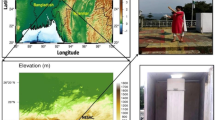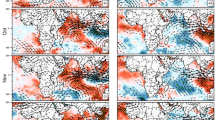Abstract
Global warming is the average temperature of the earth’s surface which has increased over the past century by about 0.6 °C. This rising temperature may vary precipitation patterns, more frequent droughts, rise in sea level and intense storms and can be termed as climate change. To understand uneven precipitation pattern for monsoon dominated region like India, there is a need to study cloud processes at high resolution with the help of cloud microphysical properties. Ocean is the major and primary source of cloud whereas local water bodies and re-evaporated water over land could be secondary source. Paper focuses over ocean (Arabian Sea) as well as over land (central India) to know the effect of global warming on cloud microphysical properties such as cloud effective radius and cloud liquid water content. Warming signal in terms of rise in sea surface temperature (0.1 °C/decade) as well as rise in surface air temperature (0.05 °C/decade) are observed over Arabian Sea and central India respectively. Satellite data show an increasing (0.5 µm/decade) trend in cloud effective radius over Arabian Sea, whereas it decreases (− 0.1 µm/decade) over central India. Increasing trend in temperature and cloud properties is may be due to warming signal. Aerosol concentration over ocean and land further helped to understand cloud processes with cloud microphysical properties. Paper will focus on the effect of warming signal in cloud properties over Arabian Sea and central India. This type of high resolution study may help to understand cloud processes which in turn may help to understand precipitation patterns.






Similar content being viewed by others
References
Altaratz, O., Koren, I., Remer, L. A., & Hirsch, E. (2014). Review: cloud invigoration by aerosols coupling between microphysics and dynamics. Atmospheric Research, 140–141, 38–60.
Bhattacharya, A., Chakraborty, A., & Venugopal, V. (2013). Variability of cloud liquid water and ice over South Asia from TMI estimates. Climate Dynamics, 42(9–10), 2411–2421.
Chelani, A. B. (2015). Study of temporal variations in aerosol optical depth over Central India. International Journal of Environmental Protection, 5(1), 25–31.
Chylek, P., Dubey, M. K., & Lohmann, U. (2006). Aerosol indirect effect over the Indian Ocean. Geophysical Research Letters, 33(6), L06806(1–4).
Ciccarelli, N., Hardenberg, J. V., Provenzale, A., Ronchi, C., Vargiu, A., & Pelosini, R. (2008). Climate variability in north-western Italy during the second half of the 20th century. Global and Planetary Change, 63, 185–195.
COBE-SST2 data provided by the NOAA/OAR/ESRL PSD, Boulder, Colorado, USA. https://www.esrl.noaa.gov/psd/data/gridded/index.html. Accessed 5 Feb 2018
Fealy, R., & Sweeney, J. (2007). Statistical downscaling of precipitation for a selection of sites in Ireland employing a generalised linear modelling approach. International Journal of Climatology, 27, 2083–2094.
Galli, C., Nardino, M., Levizzani, V., Rizzi, R., & Georgiadis, T. (2004). Radiative energy partition and cloud radiative forcing at a Po valley site. Atmospheric Research, 72, 329–351.
Giovanni data provided by Earth Data, NASA, USA. https://giovanni.gsfc.nasa.gov/giovanni/. Accessed 10 Apr 2018.
Goswami, B. N., Venugopal, V., Sengupta, D., Madhusoodanan, M. S., & Xavier, P. K. (2006). Increasing trend of extreme rain events over India in a warming environment. Science, 314(5804), 1442–1445.
Hirahara, S., Ishii, M., & Fukuda, Y. (2014). Centennial-scale sea surface temperature analysis and its uncertainty. Journal of Climate, 27, 57–75.
Holben, B. N., Tanre, D., & Smirnov, A. (2001). An emerging ground-based aerosol climatology: aerosol optical depth from AERONET. Journal of Geophysical Research D, 106(11), 12067–12097.
Huang, B., Angel, W., & Boyer, T. (2018). Evaluating SST Analyses with Independent Ocean Profile Observations. Journal of Climate, 31(13), 5015–5030.
Iguchi, T., Kozu, T., Kwiatkowski, J., Meneghini, R., Awaka, J., & Okamoto, K. (2009). Uncertainties in the rain profiling algorithm for the TRMM precipitation radar. Journal of the Meterological Society of Japan, 87A, 1–30.
IPCC. (2014). Summary for Policymakers: Climate Change 2014: The Physical Science Basis. Contribution of Working Group I to the Fifth Assessment Report of the Intergovernmental Panel on Climate Change. Cambridge, New York: Cambridge University Press.
Ishii, M., Shouji, A., Sugimoto, S., & Matsumoto, T. (2005). Objective analyses of sea - surface temperature and marine meteorological variables for the 20th century using ICOADS and KOBE collection. International Journal of Climatology, 25, 865–879.
Jaswal, A. K., Singh, V., & Bhambak, S. R. (2012). Relationship between sea surface temperature and surface air temperature over Arabian Sea, Bay of Bengal and Indian Ocean. The Journal of Indian Geophysical Union, 16(2), 41–53.
Kalnay, E., Kanamitsu, M., Kistler, R., Collins, W., Deaven, D., Gandin, E., et al. (1996). The NCEP/NCAR 40—year reanalysis project. American Meteorological Society, 77, 437–471.
Kennedy, J. J. (2014). A review of uncertainty in in situ measurements and data sets of sea surface temperature. Reviews of Geophysics, 52(1), 1–32.
King, M., Tsay, S. C., Platnick, S., Wang, M., & Liou, K.-N. (1997). Cloud retrieval algorithms for MODIS: Optical thickness, effective particle radius and thermodynamic phase. MODIS Algorithm Theoretical Basis, Document No. ATBD-MOD-05.
King, M. D., Platnick, S., Menzel, W. P., Ackerman, S. A., & Hubanks, P. A. (2013). Spatial and temporal distribution of clouds observed by MODIS onboard the Terra and Aqua satellites. IEEE Transactions on Geoscience and remote sensing, 51(7), 3826–3852.
Kummerow, C., Hong, Y., Olson, W., Yang, S., Adler, R., McCollum, J., et al. (2001). The evolution of the Goddard Profiling Algorithm (GPROF) for rainfall estimation from passive microwave sensors. Journal of Applied Meterology, 40(11), 1801–1820.
Mooney, P. A., Mulligan, F. J., & Fealy, R. (2011). Comparison of ERA-40, ERA-Interim and NCEP/NCAR reanalysis data with observed surface air temperatures over Ireland. International Journal of Climatology, 31, 545–557.
Myhre, G., Shindell, D., Breon, F. M., Collins, W., Fuglestvedt, J., Haung, J., et al. (2013). Anthropogenic and natural radiative forcing. In T. F. Stocker, D. Qin, G. K. Plattner, M. Tignor, S. K. Allen, J. Boschung, A. Nauels, Y. Xia, V. Bex, & P. M. Midgley (Eds.), Climate change 2013: the physical science basis. Contribution of working group I to the fifth assessment report of the intergovernmental panel on climate change. Cambridge: Cambridge University Press.
Nakajima, T., & King, M. D. (1990). Determination of the optical thickness and effective radius of clouds from reflected solar radiation measurement. Part I: theory. Journal of Atmospheric Science, 47, 1878–1893.
Nakajima, T., King, M. D., Radke, L. F., & Spinhirne, J. D. (1991). Determination of the optical thickness and effective particle radius of clouds from reflected solar radiation measurements. Part II: marine stratocumulus observations. Journal of the Atmospheric Sciences, 48(5), 728–750.
NCEP/NCAR Reanalysis data provided by the NOAA/OAR/ESRL PSD, Boulder, Colorado, USA. https://www.esrl.noaa.gov/psd/data/gridded/index.html. Accessed 15 Mar 2018.
Peng, Y., Lohmann, U., Leaitch, R., Banic, C., & Couture, M. (2002). The cloud albedo—cloud droplet effective radius relationship for clean and polluted clouds from RACE and FIRE.ACE. Journal of geophysical research, 107, 4106.
Penner, J. E., Xu, L., & Wang, M. (2011). Satellite methods underestimate indirect climate forcing by aerosols. Proceedings of the National Academy of Sciences of the United States of America, 108, 13404–13408.
Platnick, S., King, M. D., Ackerman, S. A., Paul Menzel, W., Baum, B. A., Riédi, J. C., et al. (2003). The MODIS cloud products: algorithms and examples from Terra. IEEE Transactions on Geoscience and remote sensing, 41, 459–473.
Ramachandran, S., & Kedia, S. (2013). Aerosol-Precipitation Interactions over India: Review and Future Perspectives. Advances in Meteorology, 2013, 1–20. https://doi.org/10.1155/2013/649156.
Rayner, N., Parker, D., Horton, E., Folland, C., Alexander, L., Rowell, D., et al. (2003). Global analyses of sea surface temperature, sea ice, and night marine air temperature since the late nineteenth century. Journal of Geophysical Research, 108(D14), 4407-ACL-2, 1–20. https://doi.org/10.1029/2002JD002670.
Remer, L. A., Kleidman, R. G., Levy, R. C., Kaufman, Y. J., Tanre, D., Mattoo, S., et al. (2008). Global aerosol climatology from the MODIS satellite sensors. Journal of Geophysical Research, 113(D14S07), 1–18. https://doi.org/10.1029/2007JD009661.
Roxy, M., & Tanimoto, Y. (2007). Role of SST over the Indian Ocean in influencing the intraseasonal variability of the Indian Summer Monsoon. Journal of the Meterological Society of Japan, 85(3), 349–358.
Roxy, M. K., Ghosh, S., Pathak, A., Athulya, R., Mujumdar, M., Murtugudde, R., et al. (2017). A threefold rise in widespread extreme rain events over central India. Nature communications, 8, 708.
Poveda, G., Waylen, P., & Pulwarty, R. (2006). Annual and inter-annual variability of the present climate in northern South America and southern Mesoamerica. Paleogeography, Palaeoclimatology, Palaeoecology, 234, 3–27.
Rhein, M., Rintoul, S. R., Aoki, S., Campos, E., Chambers, D., Feely, R. A., et al. (2013). Observations: ocean. In T. F. Stocker, D. Qin, G.-K. Plattner, M. Tignor, S. K. Allen, J. Boschung, A. Nauels, Y. Xia, V. Bex, & P. M. Midgley (Eds.), Climate change 2013: the physical science basis. Contribution of working group I to the fifth assessment report of the intergovernmental panel on climate change. New York: Cambridge University Press, Cambridge.
Simmons, A. J., Jones, P. D., da Costa Bechtold, V., Beljaars, A. C. M., Kallberg, P. W., Saarinen, S., et al. (2004). Comparison of trends and low-frequency variability in CRU, ERA-40, and NCEP//NCAR analyses of surface air temperature. Journal of Geophysical Research, 109(D24). https://doi.org/10.1029/2004JD005306.
Stammerjohn, S., Martinson, D., Smith, R., & Iannuzzi, R. (2008). Sea ice in the western Antarctic Peninsula region: Spatio-temporal variability from ecological and climate change perspectives. Deep Sea Research II, 55, 2041–2058.
Tiwari, S., Mishra, A. K., & Singh, A. K. (2016). Aerosol Climatology over the Bay of Bengal and Arabian Sea Inferred from Space-Borne Radiometers and Lidar Observations. Aerosol and Air Quality Research, 16(11), 2855–2868.
Twomey, S. (1977). The influence of pollution on the shortwave albedo of clouds. Journal of Atmospheric Science, 34, 1149–1152.
Wacker, S., Gröbner, J., Nowak, D., Vuilleumier, L., & Kämpfer, N. (2011). Cloud effect of persistent stratus nebulosus at the Payerne BSRN site. Atmospheric Research, 102, 1–9.
Wang, S., McGrath, R., Semmlar, T., & Sweeney, C. (2006). Validation of simulated precipitation patterns over Ireland for the period 1961–2000. International Journal of Climatology, 26, 251–266.
Zeng, S., Riedi, J., Trepte, C. R., Winker, D. M., & Hu, Y.-X. (2014). Study of global cloud droplet number concentration with A-Train satellites. Atmospheric Chemistry and Physics, 14, 7125–7134.
Author information
Authors and Affiliations
Corresponding author
Rights and permissions
About this article
Cite this article
Shah, R., Srivastava, R. Effect of Climate Change on Cloud Properties Over Arabian Sea and Central India. Pure Appl. Geophys. 176, 2729–2738 (2019). https://doi.org/10.1007/s00024-019-02125-3
Received:
Revised:
Accepted:
Published:
Issue Date:
DOI: https://doi.org/10.1007/s00024-019-02125-3




